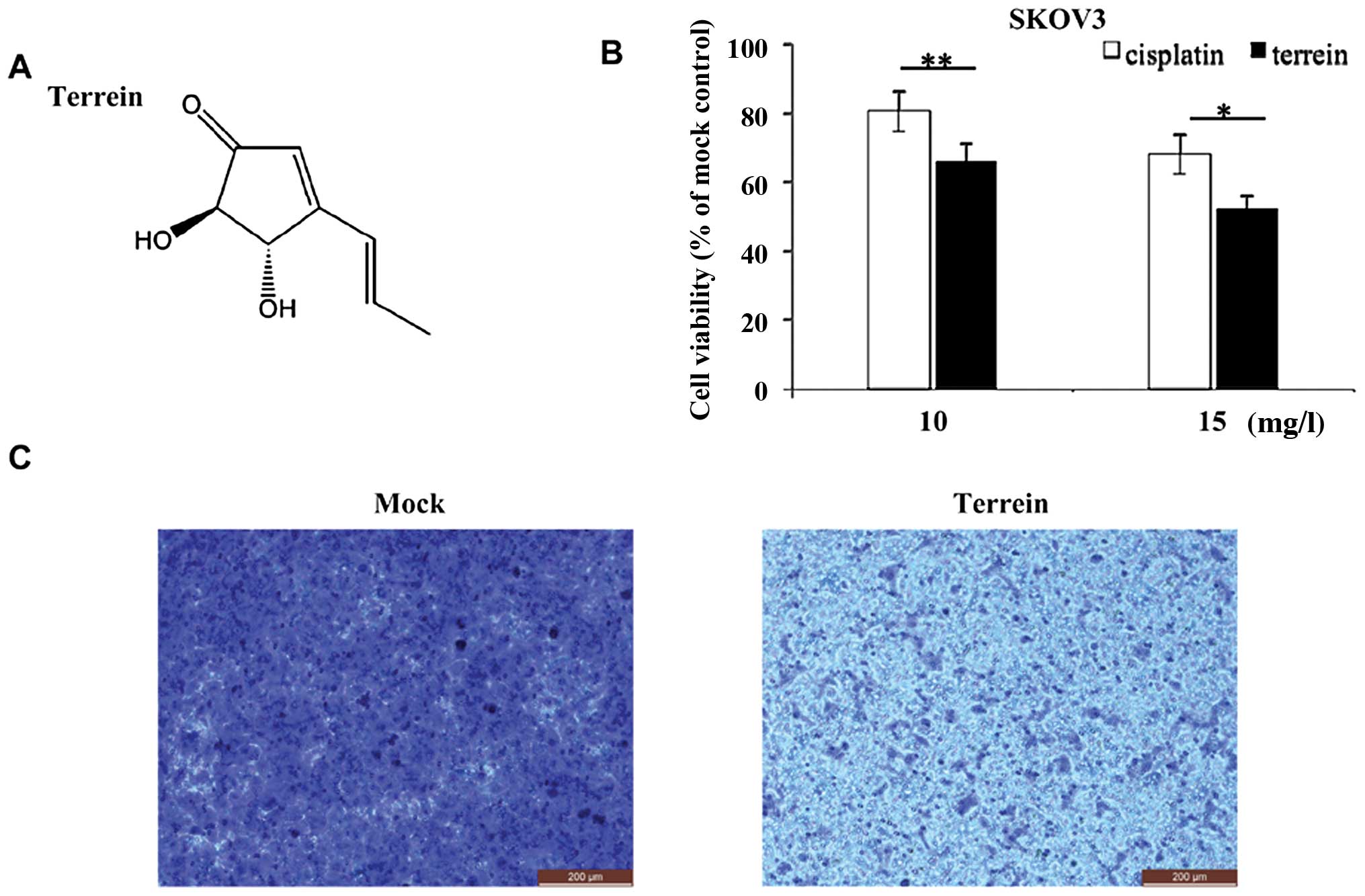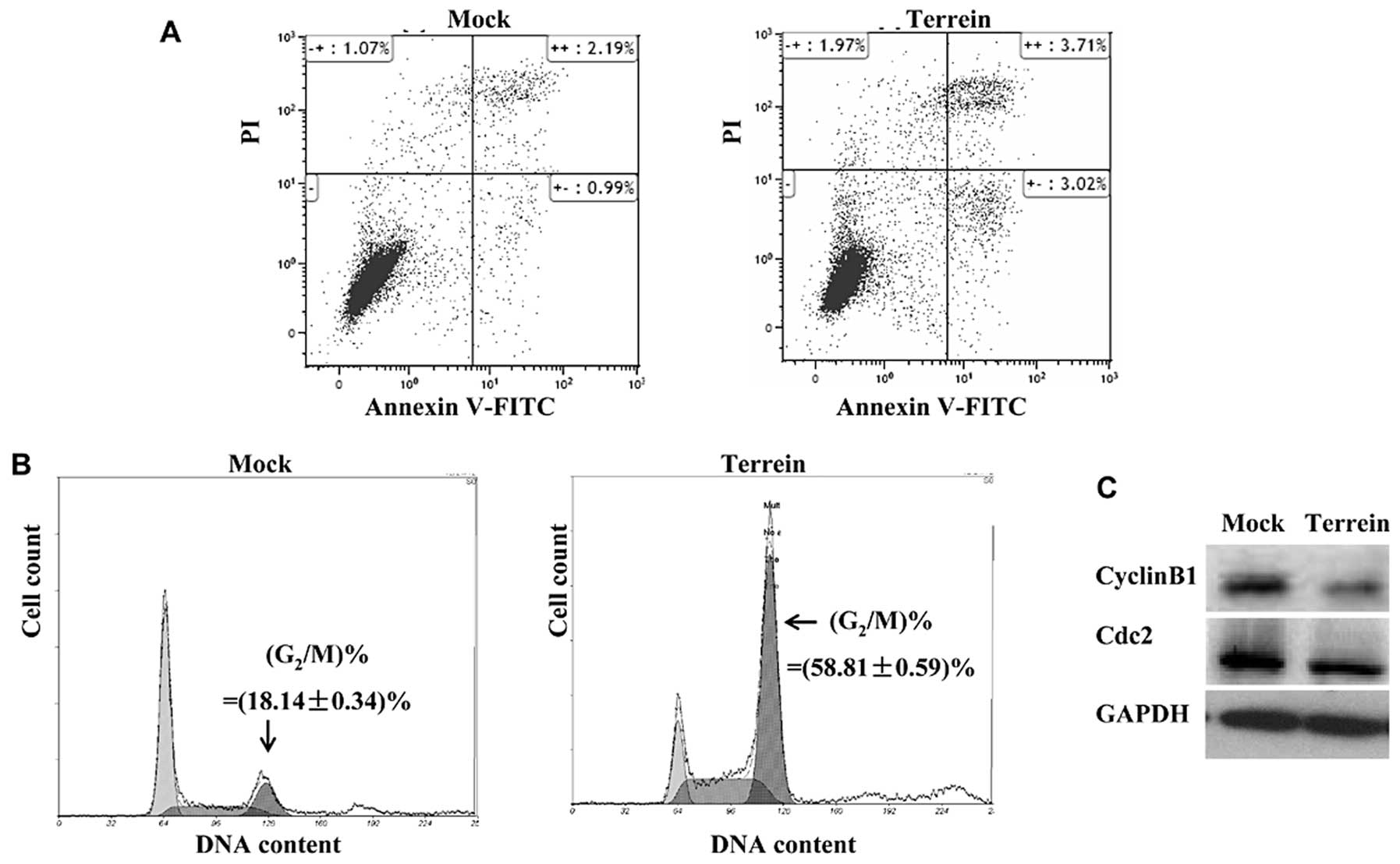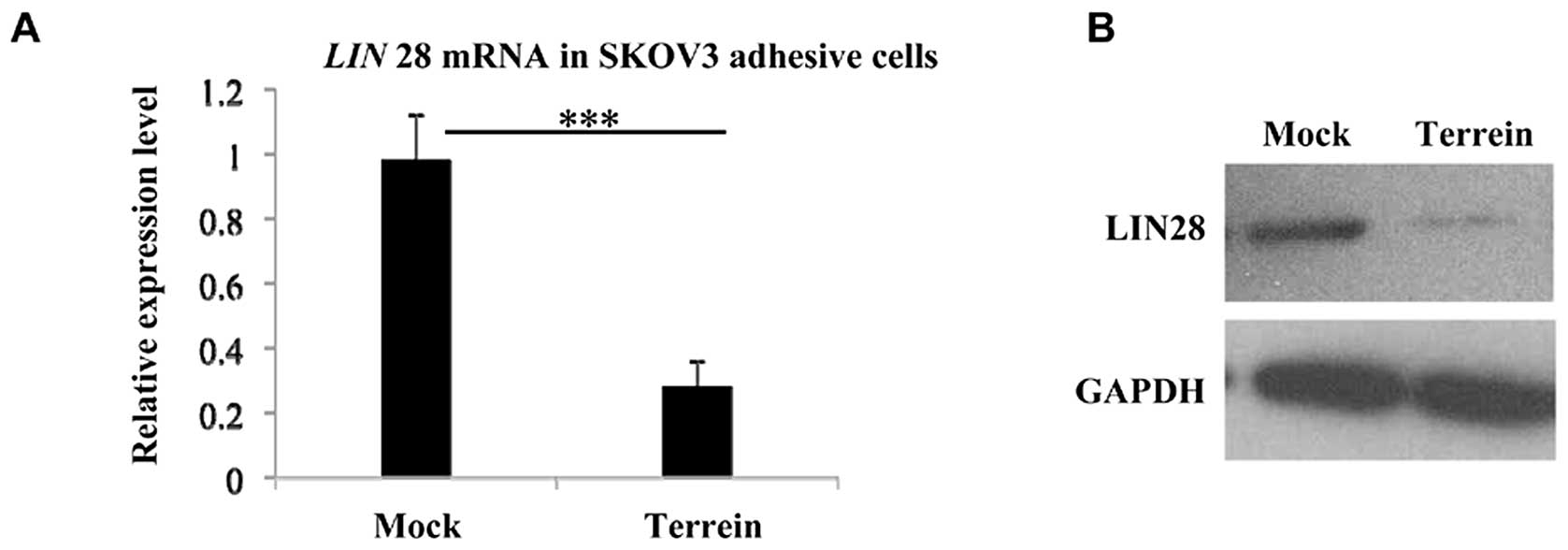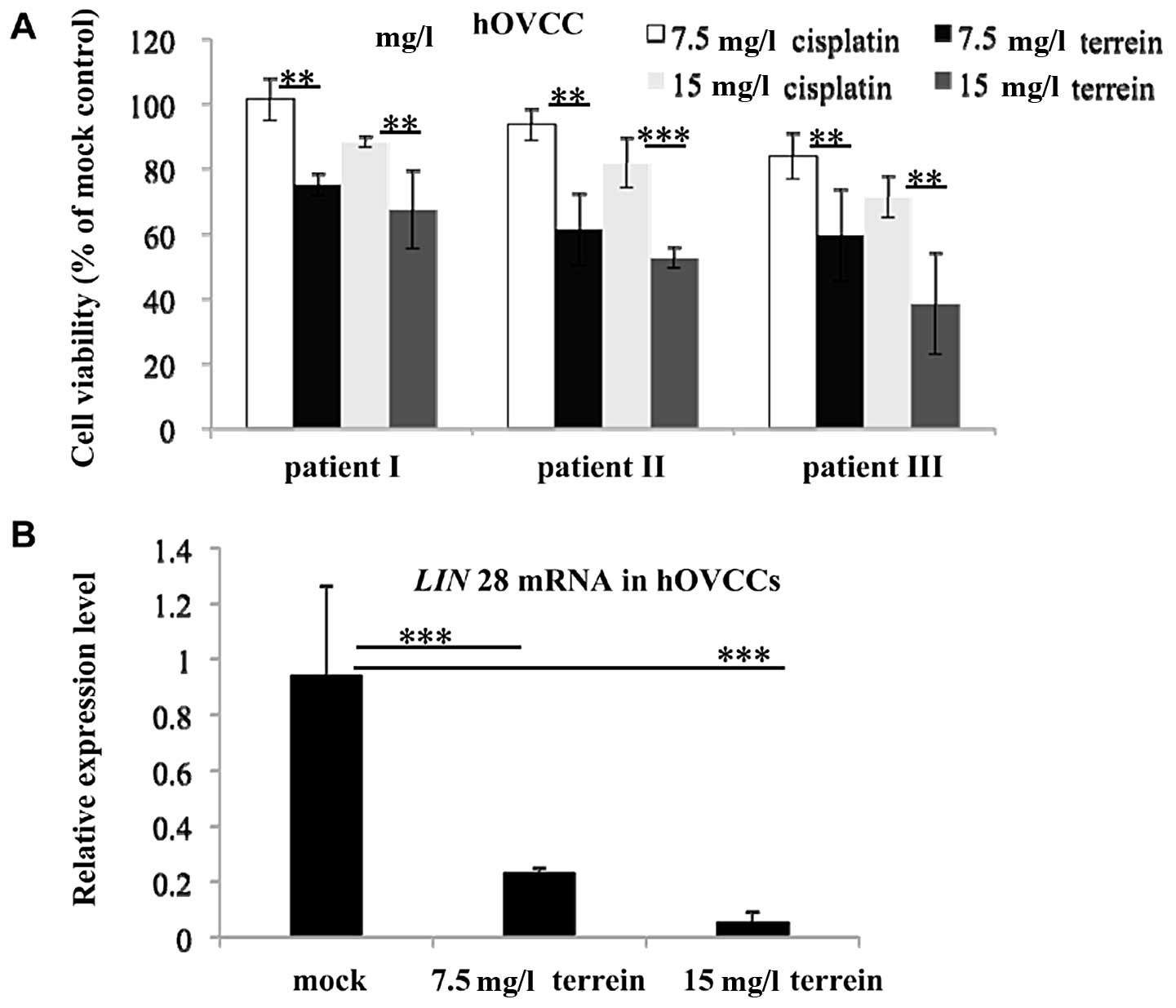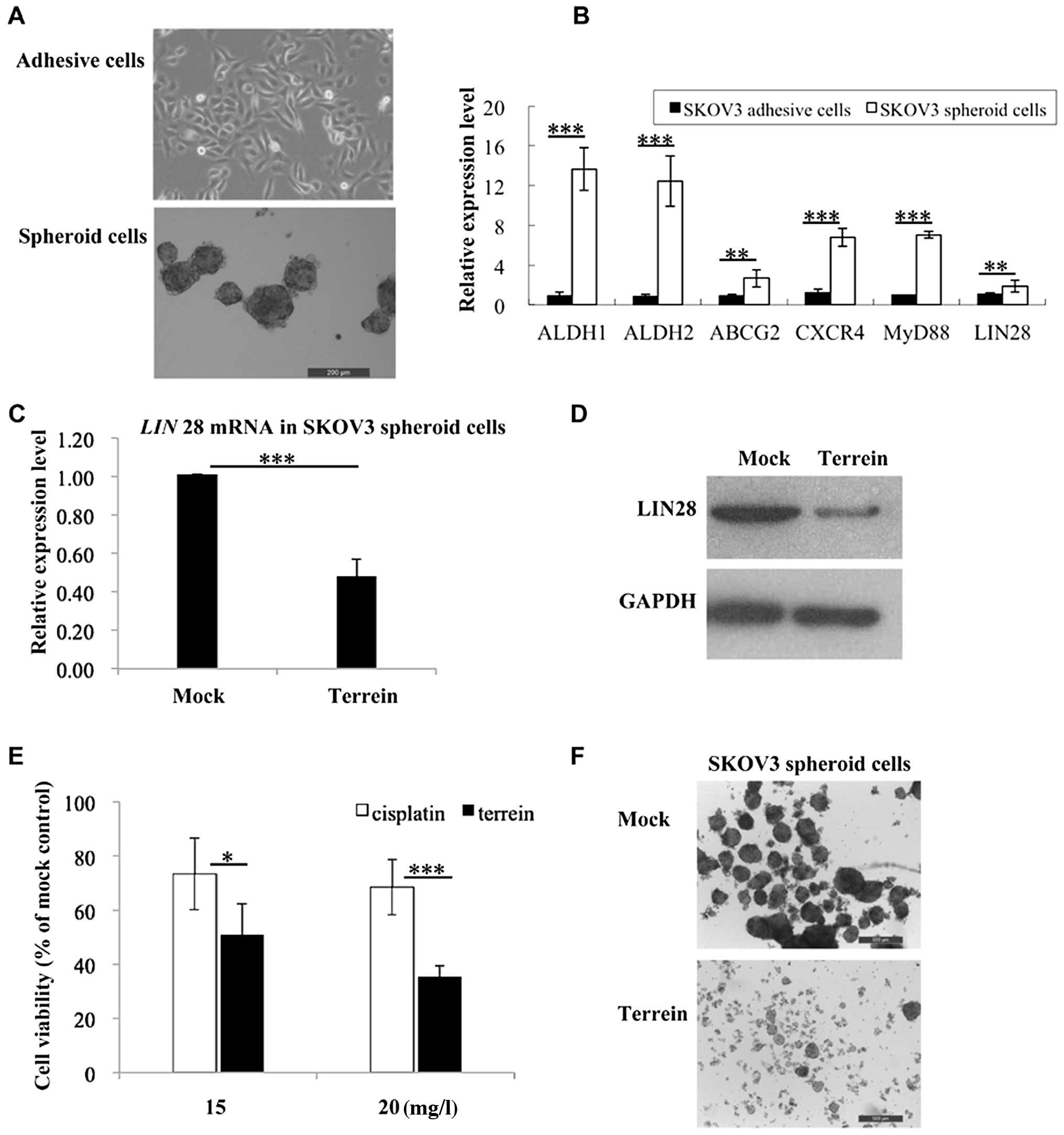The marine-derived fungal metabolite, terrein, inhibits cell proliferation and induces cell cycle arrest in human ovarian cancer cells
- Authors:
- Published online on: October 13, 2014 https://doi.org/10.3892/ijmm.2014.1964
- Pages: 1591-1598
Abstract
Introduction
Epithelial ovarian cancer is the most common and fatal gynecological malignancy, and is associated with a 5-year survival rate of approximately 30%. The standard therapeutic strategy comprises optimal cytoreductive surgery followed by cisplatin-based systemic chemotherapy. Although the initial results of this debulking followed by chemotherapy are usually good, the majority patients relapse in <5 years due to chemoresistance (1–5). Several mechanisms have been reported to account for drug resistance (6), among which cancer stem cells have been widely studied in different tumor models over the past decade (4,6,7).
According to this model, a pool of cancer stem cells, which are capable of both self-renewal and differentiation, is the initiating contributor towards tumor pathogenesis, drug resistance and recurrence (8–11). Cancer stem cells are highly resistant to chemotherapy due to their stem cell properties, mainly their quiescence and the expression of drug membrane transporters. Therefore, cancer stem cells can survive the therapy regimen and regenerate tumors, thus leading to relapse. The development of novel drug candidates and therapeutic strategies against ovarian cancer should therefore address the need to combat both differentiated and stem cell populations.
Previous studies have demonstrated the feasibility of isolating, enriching and propagating cancer stem-like cells (CSLCs), highly expressing stemness marker genes [such as aldehyde dehydrogenase (ALDH1), ALDH2, ATP-binding cassette, sub-family G (WHITE), member 2 (ABCG2), chemokine (C-X-C motif) receptor 4 (CXCR4), myeloid differentiation primary response 88 (MyD88) and lin-28 homolog A (C. elegans) (LIN28)] and being able to develop xenograft tumors with high efficiency from ovarian cancer cells (11–13). More importantly, CSLCs have been found not only in primary tumor samples, but also in immortalized cell lines and long-term culture cancer cells (14–17).
In our previous studies employing a serum-free suspension culturing system, we successfully enriched CSLCs from ovarian cancer cell lines in vitro (18–21). These CSLCs formed non-adherent spheroids and displayed remarkable stem cell properties, with higher drug resistance and tumorigenic efficiency than their differentiated counterparts. This system provides us with a valuable investigating system with which to screen novel drug candidates against human ovarian cancer cells (hOVCCs) and CSLCs.
In the present study, we aimed to investigate the anticancer effects of a bioactive fungal metabolite, namely terrein, against both hOVCCs and CSLCs. Terrein (4,5-dihydroxy-3-[(E)-1′-propenyl]-2-cyclopenten-l-one, C8H10O3) was first isolated from Aspergillus terreus Thom in 1935 (22), and has since been tested in several applications across different fields, including the fields of medicine, cosmetology and agriculture (23–29). However, the biological function of terrein in targeting human diseases has not been extensively investigated. Studies have demonstrated the strong anti-proliferative effects of terrein on skin equivalents through the induction of G2/M cell cycle arrest (27,30), suggesting its potential as a valuable candidate for treating hyper-proliferative skin diseases. However, the antitumor activity of terrein remains to be investigated.
In our previous studies, we successfully isolated the (+)-terrein from the fermentation broth of the marine sponge-derived fungus, Aspergillus terreus strain PF26, with high production efficiency and high quality (31,32). In the present study, we aimed to investigate the anticancer effects of terrein isolated in this manner on a human epithelial ovarian cancer model.
Materials and methods
Terrein preparation and cell culture
Terrein was separated from the fermentation broth of Aspergillus terreus strain PF-26 (31,32), and subjected to identification and quantification by high-performance liquid chromatography (HPLC) as previously described (31). The human ovarian epithelial cancer cell line, SKOV3, was purchased from the Shanghai Cell Bank of the Chinese Academy of Sciences (Shanghai, China). Adherent SKOV3 cells were cultured in regular culture plates at 37°C, in a humidified environment containing 5% CO2 with the McCoy’s 5A medium (Sigma-Aldrich, St. Louis, MO, USA), supplemented with 10% fetal bovine serum (FBS; HyClone, Logan, UT, USA), 100 units/ml penicillin and 100 μg/ml streptomycin.
Primary human epithelial ovarian tumor cells were isolated from the tumors of 3 patients classified as stage III, grade 2–3 serous adenocarcinoma according to the International Federation of Gynecology and Obstetrics (FIGO) classification. The study was approved by the Institutional Review Board at Shanghai Jiaotong University (Shanghai, China). The cells were cultured in the McCoy’s 5A medium (Sigma-Aldrich), supplemented with 10% fetal bovine serum (FBS; HyClone), 100 units/ml penicillin and 100 μg/ml streptomycin. Cisplatin was purchased from Sigma-Aldrich, dissolved in DMSO and added to the culture medium where indicated.
Enrichment of CSLCs
Ovarian CSLCs were enriched as previously described (21). Upon reaching 80% confluence, the SKOV3 cells were dissociated by 0.25% Trypsin-EDTA (Life Technologies, Carlsbad, CA, USA) for 1–2 min at 37°C. Single cells were suspended in DMEM/F12 medium supplemented with 10 ng/ml basic fibroblast growth factor (bFGF; Invitrogen, Carlsbad, CA, USA) and 10% knockout serum (Gibco, Grand Island, NY, USA) in low attachment plates. The medium was renewed every 2 days following centrifugation at 800 rpm for 5 min to remove the dead cell debris. After 7 days, spheroid-shaped CSLCs were selected for further treatment or analysis.
Cell viability assay
3-(4,5-Dimethylthiazol-2-yl)-2,5-diphenyl tetrazolium bromide (MTT) assay was employed to measure cell viability. Approximately 1×104 cells were seeded per well in a 96-well plate and allowed to attach overnight. The culture medium was replaced with fresh medium containing terrein (or PBS as mock treatment). Following 48 or 72 h of treatment, cell viability was determined by MTT assay. The cells were incubated with 10 μl MTT (5 mg/ml; Sigma-Aldrich) added to the medium for 4 h at 37°C. The medium was then removed and the converted dye was solubilized with 150 μl DMSO (dimethyl sulfoxide; Sigma-Aldrich). Absorbance at 490 nm was measured on a microplate reader (Bio-Rad, Hercules, CA, USA). Each assay was repeated in at least 6-wells and each experiment was independently repeated 3 times.
Transwell assay
The migratory ability of the cells was determined by Transwell assay as previously described (21). Briefly, the cells were seeded into the top chamber of 8.0 μm Transwell invasion chambers (Corning Inc., Corning, NY, USA) in serum-free medium. Complete medium was added to the lower chambers. The cells were allowed to migrate for 24 h before being fixed in methanol and visualized by crystal violet staining. The cells which did not migrate to the lower chamber were removed by scraping. At least 3 random microscope fields of view were observed.
Cell cycle analysis
Cell cycle analysis was performed as previously described (21). The SKOV3 cells were seeded in 6-cm dishes at a density of 3×105 cells/dish and allowed to attach and proliferate for 24 h. After being treated with 15 mg/l terrein for 24 h, the cells were harvested by trypsin digestion, before being washed with PBS and fixed with 70% cold-ethanol for 24 h at −20°C. The cells were treated with RNase A for 30 min at 37°C, and then stained with propidium iodide (PI) for 30 min at 4°C. The cells were analyzed using a Cytomics™ FC500 flow cytometer (Beckman Coulter, Brea, CA, USA). Data were analyzed using Beckman Coulter CXP software.
Analysis of cell apoptosis
Following incubation with or without 15 mg/l terrein for 48 h, the SKOV3 cells were harvested and analyzed as previously described (33). Cell apoptosis assay was performed using the Annexin V-FITC Apoptosis Detection kit (Nanjing KeyGen Biotech Co., Ltd., Nanjing, China) according to the manufacturer’s instructions. The cells were analyzed using a Cytomics FC500 flow cytometer (Beckman Coulter).
Western blot analysis
The cells were washed in cold PBS, and lysed in lysis buffer [50 mM Tris (pH 7.4), 150 mM NaCl, 1% Triton X-100, 1% sodium deoxycholate, 0.1% SDS, 1 mM phenylmethylsulfonyl fluoride, 20 μg/ml aprotinin and 25 μg/ml leupeptin] for 30 min on ice. Protein was quantified by a standard BCA assay (Pierce Biotechnology, Rockford, IL, USA). Total protein (50 μg) was loaded, separated by SDS-PAGE gel, transferred onto PVDF membranes and incubated with specific antibodies overnight at 4°C. The antibodies used in the present study were rabbit monoclonal antibodies against LIN28 (1:50,000; Epitomics, Burlingame, CA, USA), against Cdc2 (1:10,000; Epitomics), against cyclin B1 (1:5000; Epitomics) and rabbit polyclonal antibodies against GAPDH (1:2,000; HangZhou HuaAn Biotechnology Co., Ltd, Hangzhou, China). This was followed by incubation with HRP (horseradish peroxidase)-conjugated anti-rabbit IgG secondary antibodies (1:1,000; Beyotime Institute of Biotechnology, Shanghai, China) for 1 h at room temperature. Immunoblot signals were visualized using SuperSignal West Pico Chemiluminescent Substrate (Pierce Biotechnology).
Quantitative PCR
RNA extraction and quantitative PCR were performed as previously described (33). The cells were harvested after being rinsed with PBS; RNA was extracted using TRIzol reagent (Life Technologies) according to the manufacturer’s instructions. DNase I (Fermentas, Hanover, MD, USA) was used to exclude genomic DNA contamination. cDNA was synthesized with random primers by a ReverTra Aca-α kit (Toyobo Co., Ltd., Osaka,. Japan). The expression of ALDH1, ALDH2, ABCG2, CXCR4 and MyD88 was evaluated by quantitative PCR. Quantitative PCR was performed with SYBR-Green real-time PCR Master Mix Plus (Toyobo) using Mastercycler ep realplex (Eppendorf, Hamburg, Germany). The primers used in the present study are listed in Table I.
Results
Anti-proliferative effects of terrein on human epithelial ovarian cancer cells
We extracted and purified terrein from the fermentation broth of the marine sponge-derived fungus, Aspergillus terreus strain PF26, with high production efficiency and high quality as previously described (31,32). The structure of terrein is illustrated in Fig. 1A. To determine whether terrein exerts anticancer effects against human epithelial ovarian cancer, we first evaluated its anti-proliferative effects on a cisplatin-resistant human epithelial ovarian cancer cell line (SKOV3).
As shown in Fig. 1B, cisplatin, used as a clinical reference, displayed moderate anticancer activity against the SKOV3 cells. By contrast, treatment with terrein led to a more effective suppression of cell proliferation: following 48 h of incubation with 15 mg/l terrein, only ~50 viable SKOV3 cells remained. This suggests that terrein effectively inhibits the proliferation of immortalized ovarian cancer cells.
To investigate the effects of terrein on cell migration, we performed a Transwell migration assay and compared the migration of the cells treated either with PBS (mock treatment) or incubated with terrein for 24 h. After 24 h, the number of cells that had migrated to the bottom of the wells was significantly reduced following treatment with terrein (Fig. 1C), indicating that terrein attenuated the migration of SKOV3 cells. These data indicate that terrein exerts anticancer effects on ovarian cancer cells (SKOV3).
Terrein induces G2/M phase cell cycle arrest
To better characterize the anticancer activity of terrein and investigate the mechanisms underlying its anti-proliferative effects, we examined its effects on apoptosis and the cell cycle. We used SKOV3 cells, which were harvested after 48 h of incubation with 15 mg/l terrein. Flow cytometric analysis was performed using Annexin V-FITC to label the apoptotic cells and PI to stain the necrotic cells. As shown in Fig. 2A, terrein moderately induced cell apoptosis: the percentage of early apoptotic cells increased from 0.99 to 3.02% [indicated by Annexin V-FITC(+)/PI(-) labeling], and the late apoptotic percentage slightly increased from 2.19 to 3.71% [indicated by Annexin V-FITC(+)/PI(+) labeling].
We then analyzed the cell cycle distribution by staining the cells with PI. As illustrated in Fig. 2B, 24 h of treatment with 15 mg/l terrein led to a significant increase (from ~18.14 to ~58.81%) in the number of SKOV3 cells at the G2/M phase of the cell cycle. To better understand the ability of terrein to induce cell cycle arrest, we examined the expression of cyclin B1 and Cdc2, both of which play essential roles in the control of the cell cycle at the G2/M phase (34,35). Protein detection by western blot analysis revealed a notable depletion in the levels of both cyclin B1 and Cdc2 (Fig. 2C), suggesting that terrein modified the expression of the cell cycle regulators and consequently induced cell cycle arrest.
Terrein suppresses the expression of LIN28 in ovarian cancer cells
The RNA-binding protein, LIN28, has been reported to bind to and promote the translation of certain mRNAs encoding cell cycle regulators, including cyclin B1 (36–40), and thereby coordinates the cell cycle at multiple checkpoints. More importantly, LIN28 has been shown to contribute towards the malignancy of ovarian cancer and is thus believed to be a potential target for ovarian cancer therapy (41,42). It also should be noted that LIN28 is used to define stemness in several tissue lineages and, when highly expressed, is associated with the stemness properties of ovarian cancer stem cells (43–45).
To gain insight into the anticancer mechanisms of terrein, we investigated whether it affects the expression of LIN28 in SKOV3 cells. Firstly, we assessed LIN28 expression at the transcriptional level by quantitative PCR, and observed a clear decrease following incubation of the cells with terrein (Fig. 3A). Using western blot analysis, we then examined the suppressive effects of terrein on LIN28 at the translational level. As shown in Fig. 3B, the level of LIN28 protein was significantly depleted in the SKOV3 cells which had been incubated with terrein for 48 h.
In order to further confirm the anti-proliferative effects of terrein on epithelial ovarian cancer cells, we examined the anticancer effects of terrein on primary hOVCCs isolated from the tumors of 3 patients, classified as stage III, grade 2–3 serous adenocarcinoma. MTT assay revealed that treatment with terrein led to an marked reduction in cell viability (Fig. 4A). Although the anti-proliferative effects were not uniform on the different samples, the efficiency of terrein was consistently higher than that of cisplatin. In accordance with the results obtained with the SKOV3 cells, terrein also downregulated the expression of LIN28 in the hOVCCs (Fig. 4B). These results indicate that terrein exerts anti-proliferative effects and suppresses the expression of LIN28 in both immortalized cells and primary hOVCCs.
Terrein effectively inhibits the survival of CSLCs
Since terrein downregulated the expression of LIN28 in the hOVCCs, we wished to determine whether it would have the same effects on ovarian cancer stem cells, in which LIN28 has been reported to be an essential regulator (38–45).
We have previously reported the feasibility of enriching and propagating human ovarian CSLCs by culturing SKOV3 spheroid cells under serum-free conditions (18–21). Employing this serum-free culture system, we examined the anticancer effects of terrein on CSLCs. As shown in Fig. 5A, the enriched CSLCs grew as spheroid-shaped cells and could be easily distinguished from the original differentiated SKOV3 adhesive cells. To further confirm the stem cell characteristics of the CSCLs, we assessed the expression levels of several cancer stem cell markers including, ALDH1, ALDH2, ABCG2, CXCR4, MyD88 and LIN28. Quantitative PCR revealed that the expression of these markers was noticeably increased in the spheroid-shaped cells (Fig. 5B), thus, validating their cancer stem cell-like properties.
As shown in Fig. 5B, the enriched CSLCs displayed higher expression levels of LIN28 compared to the original SKOV3 cells. Of note, treatment with terrein significantly reduced the expression of LIN28 in the CSLCs at both the transcriptional and translational levels (Fig. 5C and D). Encouraged by this result, we examined the anti-proliferative effects of terrein on the CSCLs (Fig. 5E). The result showeds that cisplatin exhibited only a moderate effect in spheroid cells; however, treatment with terrein significantly depleted the cell survival of the SKOV3-derived CSLCs (Fig. 5E); incubation with 15 mg/l terrein for 72 h reduced cell viability by ~50%. Fig. 5F shows the morphological changes of SKOV3 spheroid-shaped cells following treatment with terrein: the spheroids were dispersed into single cells; treatment for a longer duration led to cell death.
Taken together, the results from our study demonstrate that terrein suppresses the expression of LIN28 and exerts anti-proliferative effects against ovarian CSLCs.
Discussion
Over the past decade, there is increasing evidence supporting the cancer stem cell theory, and cancer stem cells have been successfully separated from both primary tumor samples and immortalized cell lines (6,7,11). The separated cancer stem cells have been shown to survive in an in vitro serum-free culture system, forming spheroids and exhibiting stem-like properties (11,12). This in vitro system provides a valuable model for the screening and determining the underlying mechanisms of action of drugs against human cancers, particularly those resistant to drugs.
Epithelial ovarian cancer is the most lethal gynecological malignancy, which easily develops drug resistance, thus causing relapse (1–5). The cancer stem cell theory has significant therapeutic implications and provides a mechanistic explanation for ovarian cancer carcinogenesis and development. Based on this theory, novel drugs targeting cancer stem cells are urgently required; however, little is known at present (46).
In this study, we demonstrate that one small compound, namely terrein, effectively exerts anticancer effects in both differentiated and stem-like ovarian cancer cells. Terrein is a fungal metabolite which has already been shown to have valuable bioactivity in the fields of medicine, cosmetology and agriculture without any cytotoxic effects (22–30). In the present study, we separated terrein from the fermentation broth of sponge-derived fungus with high efficiency and purity, showing it to be an economic and environmentally-friendly drug candidate (31). Our results revealed that terrein effectively inhibited the proliferation of both immortalized ovarian cancer cells and primary hOVCCs. Our investigation into the underlying mechanisms revealed that terrein induced G2/M phase cell cycle arrest by suppressing the expression of G2/M cell cycle-related proteins (cyclin B1 and Cdc2). More importantly, we identified that an important target of terrain is LIN28, an evolutionarily conserved protein which plays a critical role in embryonic development (38). LIN28 has also been reported to be an essential oncogene in ovarian cancer, contributing to the etiology and progression (41–43). Recently, LIN28 has gained increasing attention due to its biological roles in cancer stem cells, and is believed to be an important marker gene for cancer stem cells (43–45).
Consequently, we sought to investigate whether terrein has the ability to target CSLCs in our in vitro experimental system. We found that terrein effectively suppressed the expression of LIN28 and significantly reduced the viability of CSLCs, suggesting that terrein also possesses the ability to target cancer stem cells.
Thus, it can be concluded that terrein, an easily produced small molecule, may prove to be a promising drug candidate for use in the treatment of human epithelial ovarian cancer with a novel mechanism of action targeting both differentiated and stem-like ovarian cancer cells.
Acknowledgements
The present study was supported by grants from the Shanghai Jiaotong University (YG2011ms13), the Shanghai Municipal Health and Family Planning Commission (20134Y128), the Shanghai Jiaotong University School of Medicine (13XJ10067), the National Natural Science Foundation of China (No. 81401216) and the Shanghai Committee of Science and Technology (14YF1408200).
References
|
Schwartz PE: Current diagnosis and treatment modalities for ovarian cancer. Cancer Treat Res. 107:99–118. 2002.PubMed/NCBI | |
|
Cho KR and Shih IeM: Ovarian cancer. Annu Rev Pathol. 4:287–313. 2009. View Article : Google Scholar | |
|
Sudo T: Molecular-targeted therapies for ovarian cancer: prospects for the future. Int J Clin Oncol. 17:424–29. 2012. View Article : Google Scholar : PubMed/NCBI | |
|
Foster R, Buckanovich RJ and Rueda BR: Ovarian cancer stem cells: working towards the root of stemness. Cancer Lett. 338:147–157. 2013. View Article : Google Scholar : PubMed/NCBI | |
|
Jemal A, Bray F, Center MM, Ferlay J, Ward E and Forman D: Global cancer statistics. CA Cancer J Clin. 61:69–90. 2011. View Article : Google Scholar | |
|
Dean M, Fojo T and Bates S: Tumour stem cells and drug resistance. Nat Rev Cancer. 5:275–284. 2005. View Article : Google Scholar | |
|
Dalerba P, Cho RW and Clarke MF: Cancer stem cells: models and concepts. Annu Rev Med. 58:267–284. 2007. View Article : Google Scholar : PubMed/NCBI | |
|
Nguyen LV, Vanner R, Dirks P and Eaves CJ: Cancer stem cells: an evolving concept. Nat Rev Cancer. 12:133–143. 2012.PubMed/NCBI | |
|
Chen J, Li Y, Yu TS, McKay RM, Burns DK, Kernie SG and Parada LF: A restricted cell population propagates glioblastoma growth after chemotherapy. Nature. 488:522–526. 2012. View Article : Google Scholar : PubMed/NCBI | |
|
Driessens G, Beck B, Caauwe A, Simons BD and Blanpain C: Defining the mode of tumour growth by clonal analysis. Nature. 488:527–530. 2012. View Article : Google Scholar : PubMed/NCBI | |
|
Bapat SA, Mali AM, Koppikar CB and Kurrey NK: Stem and progenitor-like cells contribute to the aggressive behavior of human epithelial ovarian cancer. Cancer Res. 65:3025–3029. 2005.PubMed/NCBI | |
|
Szotek PP, Pieretti-Vanmarcke R, Masiakos PT, Dinulescu DM, Connolly D, Foster R, Dombkowski D, et al: Ovarian cancer side population defines cells with stem cell-like characteristics and Mullerian Inhibiting Substance responsiveness. Proc Natl Acad Sci USA. 103:11154–11159. 2006. View Article : Google Scholar : PubMed/NCBI | |
|
Zhang S, Balch C, Chan MW, Lai HC, Matei D, Schilder JM, Yan PS, et al: Identification and characterization of ovarian cancer-initiating cells from primary human tumors. Cancer Res. 68:4311–4320. 2008. View Article : Google Scholar : PubMed/NCBI | |
|
Kondo T, Setoguchi T and Taga T: Persistence of a small subpopulation of cancer stem-like cells in the C6 glioma cell line. Proc Natl Acad Sci USA. 101:781–786. 2004. View Article : Google Scholar : PubMed/NCBI | |
|
Patrawala L, Calhoun T, Schneider-Broussard R, Zhou J, Claypool K and Tang DG: Side population is enriched in tumorigenic, stem-like cancer cells, whereas ABCG2+ and ABCG2− cancer cells are similarly tumorigenic. Cancer Res. 65:6207–6219. 2005. View Article : Google Scholar : PubMed/NCBI | |
|
Calcagno AM, Fostel JM, To KK, Salcido CD, Martin SE, Chewning KJ, Wu CP, et al: Single-step doxorubicin-selected cancer cells overexpress the ABCG2 drug transporter through epigenetic changes. Br J Cancer. 98:1515–1524. 2008. View Article : Google Scholar : PubMed/NCBI | |
|
Schmandt RE, Broaddus R, Lu KH, Shvartsman H, Thornton A, Malpica A, Sun C, et al: Expression of c-ABL, c-KIT, and platelet-derived growth factor receptor-β in ovarian serous carcinoma and normal ovarian surface epithelium. Cancer. 98:758–764. 2003. | |
|
Ma L, Lai D, Liu T, Cheng W and Guo L: Cancer stem-like cells can be isolated with drug selection in human ovarian cancer cell line SKOV3. Acta Biochim Biophys Sin. 42:593–602. 2010. View Article : Google Scholar : PubMed/NCBI | |
|
Lai D, Wang F, Chen Y, Wang C, Liu S, Lu B, Ge X, et al: Human ovarian cancer stem-like cells can be efficiently killed by γδ T lymphocytes. Cancer Immunol Immunother. 61:979–989. 2012.PubMed/NCBI | |
|
Liu T, Cheng W, Lai D, Huang Y and Guo L: Characterization of primary ovarian cancer cells in different culture systems. Oncol Rep. 23:1277–1284. 2010.PubMed/NCBI | |
|
Luo X, Dong Z, Chen Y, Yang L and Lai D: Enrichment of ovarian cancer stem-like cells is associated with epithelial to mesenchymal transition through an miRNA-activated AKT pathway. Cell Prolif. 46:436–446. 2013. View Article : Google Scholar : PubMed/NCBI | |
|
Raistrick H and Smith G: Studies in the biochemistry of micro- organisms: the metabolic products of Aspergillus terreus Thom. A new mould metabolic product-terrein. Biochem J. 29:606–611. 1935.PubMed/NCBI | |
|
Ghisalberti EL, Narbey MJ and Rowland CY: Metabolites of Aspergillus terreus antagonistic towards the take-all fungus. J Nat Prod. 53:520–522. 1990. | |
|
Arakawa M, Someno T, Kawada M and Ikeda D: A new terrein glucoside, a novel inhibitor of angiogenin secretion in tumor angiogenesis. J Antibiot (Tokyo). 61:442–448. 2008. View Article : Google Scholar : PubMed/NCBI | |
|
Park SH, Kim DS, Kim WG, Ryoo IJ, Lee DH, Huh CH, Youn SW, Yoo ID and Park KC: Terrein: a new melanogenesis inhibitor and its mechanism. Cell Mol Life Sci. 61:2878–2885. 2004. View Article : Google Scholar : PubMed/NCBI | |
|
Phattanawasin P, Pojchanakom K, Sotanaphun U, Piyapolrungroj N and Zungsontiporn S: Weed growth inhibitors from Aspergillus fischeri TISTR 3272. Nat Prod Res. 21:1286–1291. 2007.PubMed/NCBI | |
|
Kim DS, Cho HJ, Lee HK, Lee WH, Park ES, Youn SW and Park KC: Terrein, a fungal metabolite, inhibits the epidermal proliferation of skin equivalents. J Dermatol Sci. 46:65–68. 2007. View Article : Google Scholar : PubMed/NCBI | |
|
Lee JC, Yu MK, Lee R, Lee YH, Jeon JG, Lee MH, Jhee EC, Yoo ID and Yi HK: Terrein reduces pulpal inflammation in human dental pulp cells. J Endod. 34:433–437. 2008. View Article : Google Scholar : PubMed/NCBI | |
|
Lee YH, Lee NH, Bhattarai G, Oh YT, Yu MK, Yoo ID, Jhee EC and Yi HK: Enhancement of osteoblast biocompatibility on titanium surface with Terrein treatment. Cell Biochem Funct. 28:678–685. 2010. View Article : Google Scholar : PubMed/NCBI | |
|
Kim DS, Lee HK, Park SH, Lee S, Ryoo IJ, Kim WG, Yoo ID, et al: Terrein inhibits keratinocyte proliferation via ERK inactivation and G2/M cell cycle arrest. Exp Dermatol. 17:312–317. 2008. View Article : Google Scholar : PubMed/NCBI | |
|
Xu B, Yin Y, Zhang F, Li Z and Wang L: Operating conditions optimization for (+)-terrein production in a stirred bioreactor by Aspergillus terreus strain PF-26 from marine sponge Phakellia fusca. Bioprocess Biosyst Eng. 35:1651–1655. 2012. View Article : Google Scholar : PubMed/NCBI | |
|
Yin Y, Gao Q, Zhang F and Li Z: Medium optimization for the high yield production of single (+)-terrein by Aspergillus terreus strain PF26 derived from marine sponge Phakellia fusca. Process Biochem. 47:887–891. 2012. View Article : Google Scholar | |
|
Chen YF, Dong Z, Xia Y, Tang J, Peng L, Wang S and Lai D: Nucleoside analog inhibits microRNA-214 through targeting heat-shock factor 1 in human epithelial ovarian cancer. Cancer Sci. 104:1683–1689. 2013. View Article : Google Scholar : PubMed/NCBI | |
|
Cicenas J and Valius M: The CDK inhibitors in cancer research and therapy. J Cancer Res Clin Oncol. 137:1409–1418. 2011. View Article : Google Scholar : PubMed/NCBI | |
|
Collins I and Garrett MD: Targeting the cell division cycle in cancer: CDK and cell cycle checkpoint kinase inhibitors. Curr Opin Pharmacol. 5:366–373. 2005. View Article : Google Scholar : PubMed/NCBI | |
|
Hafner M, Max KE, Bandaru P, Morozov P, Gerstberger S, Brown M, Molina H and Tuschl T: Identification of mRNAs bound and regulated by human LIN28 proteins and molecular requirements for RNA recognition. RNA. 19:613–626. 2013. View Article : Google Scholar : PubMed/NCBI | |
|
Li N, Zhong X, Lin X, Guo J, Zou L, Tanyi JL, Shao Z, et al: Lin-28 homologue A (LIN28A) promotes cell cycle progression via regulation of cyclin-dependent kinase 2 (CDK2), cyclin D1 (CCND1), and cell division cycle 25 homolog A (CDC25A) expression in cancer. J Biol Chem. 287:17386–17397. 2012. View Article : Google Scholar : PubMed/NCBI | |
|
Moss EG, Lee RC and Ambros V: The cold shock domain protein LIN-28 controls developmental timing in C. elegans and is regulated by the lin-4 RNA. Cell. 88:637–646. 1997. View Article : Google Scholar : PubMed/NCBI | |
|
Shyh-Chang N and Daley GQ: Lin28: primal regulator of growth and metabolism in stem cells. Cell Stem Cell. 12:395–406. 2013. View Article : Google Scholar : PubMed/NCBI | |
|
Xu B, Zhang K and Huang Y: Lin28 modulates cell growth and associates with a subset of cell cycle regulator mRNAs in mouse embryonic stem cells. RNA. 15:357–361. 2009. View Article : Google Scholar : PubMed/NCBI | |
|
Viswanathan SR, Powers JT, Einhorn W, Hoshida Y, Ng TL, Toffanin S, O’Sullivan M, et al: Lin28 promotes transformation and is associated with advanced human malignancies. Nat Genet. 41:843–848. 2009. View Article : Google Scholar : PubMed/NCBI | |
|
Lu L, Katsaros D, Shaverdashvili K, Qian B, Wu Y, de la Longrais IA, Preti M, et al: Pluripotent factor lin-28 and its homologue lin-28b in epithelial ovarian cancer and their associations with disease outcomes and expression of let-7a and IGF-II. Eur J Cancer. 45:2212–2218. 2009. View Article : Google Scholar : PubMed/NCBI | |
|
Peng S, Maihle NJ and Huang Y: Pluripotency factors Lin28 and Oct4 identify a sub-population of stem cell-like cells in ovarian cancer. Oncogene. 29:2153–2159. 2010. View Article : Google Scholar : PubMed/NCBI | |
|
Yang X, Lin X, Zhong X, Kaur S, Li N, Liang S, Lassus H, et al: Double-negative feedback loop between reprogramming factor LIN28 and microRNA let-7 regulates aldehyde dehydrogenase 1-positive cancer stem cells. Cancer Res. 70:9463–9472. 2010. View Article : Google Scholar : PubMed/NCBI | |
|
Ma W, Ma J, Xu J, Qiao C, Branscum A, Cardenas A, Baron AT, et al: Lin28 regulates BMP4 and functions with Oct4 to affect ovarian tumor microenvironment. Cell Cycle. 12:88–97. 2013. View Article : Google Scholar : PubMed/NCBI | |
|
Sanchez-Garcia I, Vicente-Duenas C and Cobaleda C: The theoretical basis of cancer-stem-cell-based therapeutics of cancer: can it be put into practice? Bioessays. 29:1269–1280. 2007. View Article : Google Scholar : PubMed/NCBI |



